Posted: November 6th, 2015 | No Comments »
This exhibition of Thomas Child’s photographs of late Qing (1870s-1880s) Peking is only for a very short run in London…so it requires some swift planning….
Qing Dynasty Peking: Thomas Child’s Photographs runs from 10-15 November at China Exchange, 32a Gerrard Street, London.
There’s a selection of pictures here on the BBC Website –
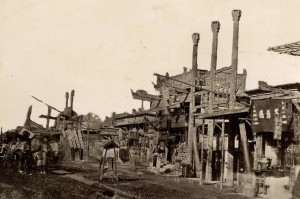
Posted: November 6th, 2015 | No Comments »
Like most relationship breakdowns we may never know the true story here…but in October 1942 Henry Wagner of the United States Navy appeared in court seeking an end to his Shanghai marriage. Wagner had been in Shanghai in 1940 with the US military when he met Ah Ling Wang. They appear to have undergone some sort of ceremony but, once he got back Stateside, Wagner decided he didn’t think the marriage was either legal or licensed. From what we can tell from this brief report he’s certainly seeking to paint Ah Ling, aka Irene Wagner, as a bit of an opportunist claiming she “desired only to be married to a white man for reasons of prestige”. Of course as the hearing was in Redwood City, California Ah Ling/Irene herself was not in attendance to make any comment on Wagner’s views concerning her. And given that the case came to court in 1942, a time when America was at war with Japan and all Shanghai under Japanese control her chances of attending the court, or even contacting it, were less than zero. It might be churlish to suggest that Mr Wagner got himself into something while shoreside in the city he later wanted to extricate himself from, but one can’t help wondering whatever happened Ah Ling Wang stuck back in Shanghai.
The newspaper jumped on the marriage as a “Shanghai Gesture” – Wagner came to court around the same time the Gene Tierney movie The Shanghai Gesture hit the cinema in 1942.
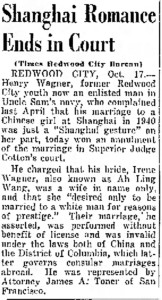
Posted: November 5th, 2015 | 1 Comment »
This post is one of a series on the old bookshops of Shanghai which includes the Uchiyama Japanese book shop, the German Book Mart store on Yu Yuen Road, the Zeitgeist left wing bookshop on North Soochow Road and the French Bookstore on Soochow Road – all of which I’ve blogged about before here, here and here respectively. The Western Arts Gallery was owned Heinz Egon Heinemann and is well remembered in several memoirs including Ernest Heppner’s Shanghai Refuge. The shop-cum-gallery specialised in buying and selling antiquarian books. A number of interesting folk worked there including Kurt Schwarz (credited as a co-founder and co-owner of the bookshop in some sources) and Illo Koratkowski (and they both deserve a bit more mention)…
The Western Arts Gallery was primarily located at 904 Weihai Road in the Settlement, though with another store and offices at 1166 Avenue Joffre (now Huai Hai Road) in the French Concession. It was effectively half a store, the other being occupied by a Mr Tsao, a Chinese curio dealer. The store was a popular meeting place for Shanghailanders, especially Germans and members of the city’s diplomatic corps. The Gallery was really more of a bookstore, with a small office, though did hold the occasional exhibition and a porcelain pagoda, large enough to reach to the ceiling, stood in the middle of the store.
Heinz Egon Heinemann was originally from Wiesbaden. He had been forced to leave Germany by the Nazis and moved to South Africa but upon discovering he could not bring his family to South Africa he left for Shanghai. As well as founding the Western Arts Gallery he owned five bookstores in Shanghai, Peking and Nanking. He stayed in Shanghai till the communist takeover when he was, unsurprisingly as so many were, arrested on charges of espionage by the Communists. In 1953 he eventually settled in Montreal (arriving with just $30 and 5 books), where he continued to be an antiquarian book dealer. He died in 1979.
Kurt Schwarz was from Vienna originally where he had studied for a Phd in art history and worked in his family’s antiquarian bookstore, Antiquariat Schwarz. After the Nazi takeover of Vienna he moved briefly to Paris and then London, where he worked as a book scout. He then applied for and was offered a post working in the library of the Royal Asiatic Society in Shanghai. That library was forced to close in 1941 and so Kurt moved to a job with the Western Arts Gallery in its bookshop. He remained in Shanghai until 1947 when he emigrated to the USA and settled in Los Angeles.
Illo Koratkowski was born in Berlin to a Jewish family. Her father, Paul (a bank manager in Germany), had moved to Shanghai to escape the Nazis but left his family behind in Berlin. He had hoped to secure transit to America and for them all to reunite there. In 1939 things in Berlin took a turn for the worse and Illo’s mother managed to get two tickets on the Trans-Siberian Railway to Dairen (Dalian) and then on to Shanghai. Paul had started an accountancy firm in Shanghai and managed to settle the family in an apartment on Hardoon Road. Illo worked briefly for a literary paper in Shanghai, but that folded. As she spoke English and French, as well as German, Heinemann, who was a client of Illo’s fathers, agreed to take her on at the Western Arts Gallery. Heinemann agreed to teach Illo all about the rare book trade as well as Western and Oriental art.
If anyone else knows anything about the Western Arts Gallery, especially should you happen to have a photo, I’d love to hear from you….
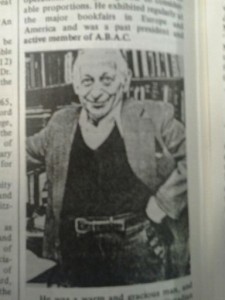
Heinz Egon Heinemann…in Montreal
Posted: November 4th, 2015 | 3 Comments »
In my last post on Shanghai’s Book Mart bookstore, patronised almost exclusively by Nazis and Nazi-sympathisers during the 1940s, I promised more information on one particular regular visitor, Dr Klaus Menhert who was perhaps the most able of the Nazi propagandists working in the city during World War Two….and so here’s some more on this particular Nazi as promised.
In July 1941 the Nazi Embassy in Tokyo ordered Dr Klaus Menhert to Shanghai. He had been living in Honolulu. His job was to start a “slick” monthly propaganda magazine for the Nazis, in English, published in Shanghai. The idea was to disseminate Nazi “aims, interests and ideologies to the foreign population of Shanghai”. The magazine was funded directly from the Propaganda Section of the Ministry for Foreign Affairs in Berlin and Menhert was paid a salary of 5,000 Reichmarks a month to do the job. Menhert created The XXth Century magazine. The first issue was published in October 1941 and the last in June 1945 (for obvious reasons). Articles were mostly from the DNB and Trans-Ocean German news agencies though notorious collaborators with the German in Shanghai, such as the American Herbert Moy, also contributed. Some vulnerable refugees and stateless residents of Shanghai were forced to contribute to keep their freedom, most notably the stateless White Russian cartoonist Sapajou. The magazine, though slickly produced, was priced artificially low (CRB 3) on the newsstands to generate sales. There was also a Japanese edition (priced at 1 Yen), printed in Shanghai, which accounted for about 50% of the magazines average monthly circulation of 3,500 copies. Interestingly the magazine rarely played up the Japanese war effort or Chinese collaborator Wang Ching-wei’s government (despite it being recognised as the official government of China by Nazi Germany). Sadly I only have a few pages of the publication on very small res – below. German firms in Shanghai – such as Bosch and Siemens as you can see below – all advertised. I can tell you the offices of The XXth Century were, interestingly, listed as “34 Ta Shanghai Lu – Tel: 16180”. Ta Shanghai Lu was the name briefly attached to what had been Avenue Joffre in the French Concession and was to later be renamed Huai-Hai Road.
Any more information, particularly any scans of the publication gratefully accepted….
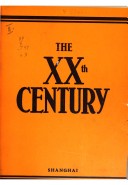
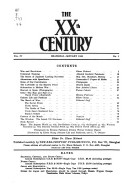
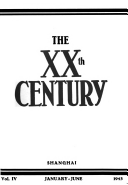
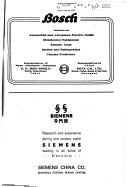
Posted: October 31st, 2015 | No Comments »
This is now really one of a series of posts about the old bookstores of Shanghai. I’ve blogged before about the Japanese-run Uchiyama Bookstore on North Szechuen Road, the French Bookshop on Szechuen Road, and also the Zeitgeist Bookshop on North Soochow Road, a favoured meeting place of Shanghailanders of a communist persuasion. Among others there was also the Book Mart, a favoured bookstore for those of a Nazi persuasion. It operated from around the time of Pearl Harbor through to around 1948 from premises at 286 Yu Yuen Road (and for the really keen – their telephone number was Shanghai: 22924 and their P.O. Box address was 1084).
The Book Mart was run by a woman who claimed to be a Hungarian “Countess” and was handily close by the Hungaria nightclub and restaurant (sorry, I don’t have a picture of the Book Mart but do have an old ad for the Hungaria) which after 1941 became a favourite night time hangout for Nazi officials in Shanghai. The shop specialised in “Antiquariat Bücher und Zeitschriften aus den Gebieten der Geschichte, Soziologie“. A major figure at literary and book events there (of which they apparently had many in the evenings was Baron von Puttkamer, the Nazi’s propaganda chief in Shanghai, as well as pro-Nazi journalist Karl von Wiegand and Nazi magazine publisher Klaus Menhert (of whom more soon). Lectures would be held there – in March 1943 a bunch of Nazis gathered to hear Dr. R. Neumann give a talk of the latest research in the field of racial physiognomy.
Wouldn’t have been my choice for a literary night, or as a handy local bookshop…but there it was all the same. Needless to say, if anyone has a photo????
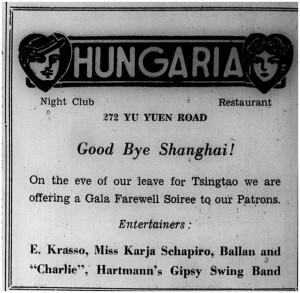
Â
Posted: October 30th, 2015 | No Comments »
Of course Shanghai is by the sea, it should have sea gulls, but it doesn’t really and it didn’t back in the day….Here, in 1942, RJ Scott, in his long running cartoon strip, Scott’s Scrap Book, explains why…….
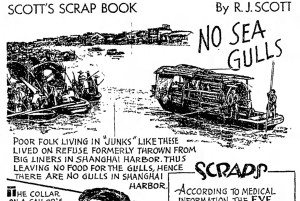
Posted: October 29th, 2015 | No Comments »
A slightly delayed and shortened LitFest this year at M on the Bund in Shanghai due to the World Congress of Art Deco also being on in the city….here’s some highlights this weekend for ChinaRhymers….

Saturday October 31:
Nisid Hajari on Midnight’s Furies and the messy partition of India in 1947 – 11am
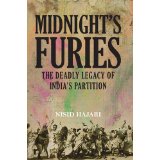
Sunday November 1:
Michael Meyer on his Manchuria book – 1pm

You can see all the line up here….
Posted: October 29th, 2015 | No Comments »
This picture of White Russian fascists in Harbin in 1934 popped up on twitter the other day, courtesy of Peter Harmsen, the author of the books Shanghai 1937 and Nanjing 1937 – you can follow his regular and interesting tweets at @chinaww2. I’ve posted myself about Russian fascists in China before but the political allegiances of the Russians in Shanghai just before and during World War Two were many and varied.

Some did form pro-fascist groups, others actively worked with the Japanese and Nazis in the hope that the USSR would be defeated and they’d be able to regain their former positions and property. However, as the article from June 1941 below shows, following the Nazi invasion of the Sioviet Union some White Russians did join with the Soviet Russian community in Shanghai to oppose the attack. This is, of course, understandable and admirable in some ways – more so than becoming fascists (of course there was always a rather large strain of anti-Semitism among many White Russians which swayed them) though sadly many of those who did seek to return to the USSR during the war and afterwards mostly ended up in Stalin’s gulags.














